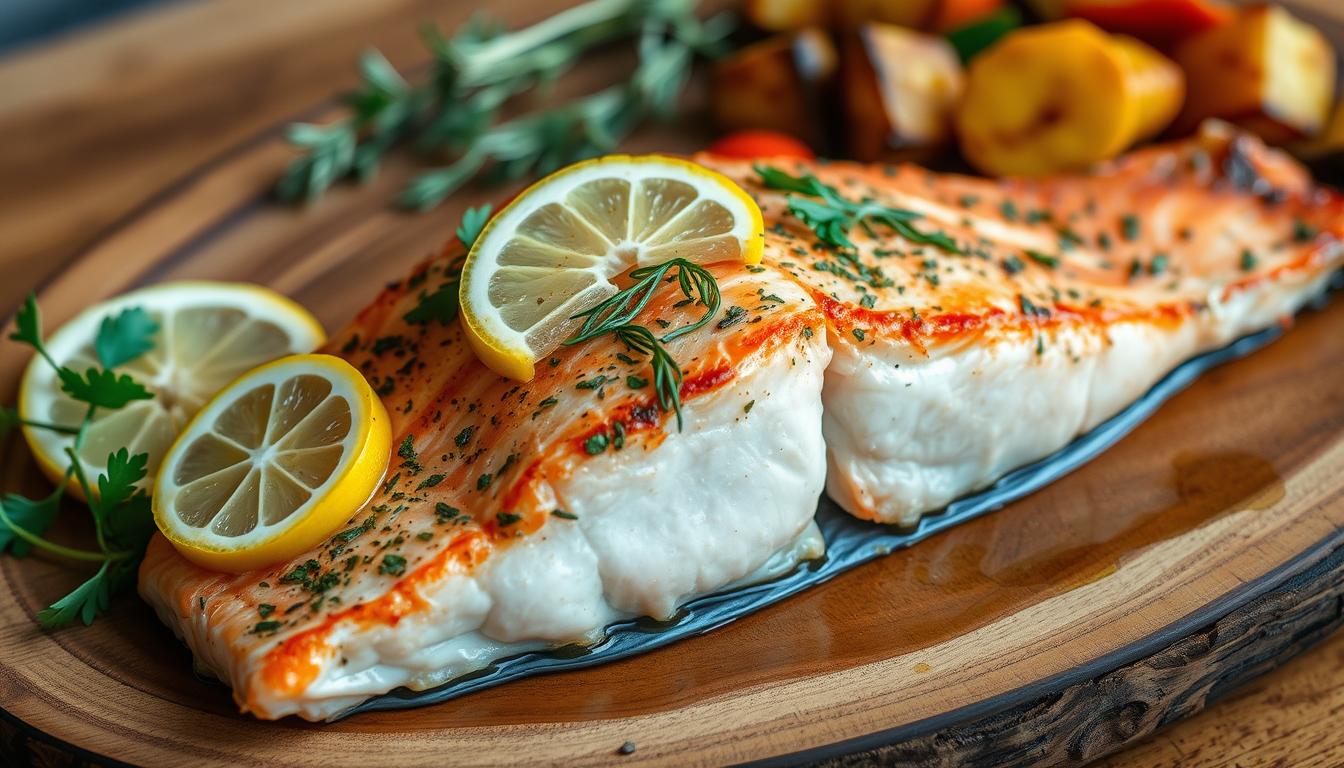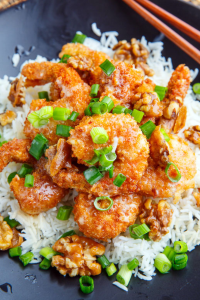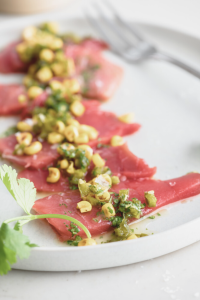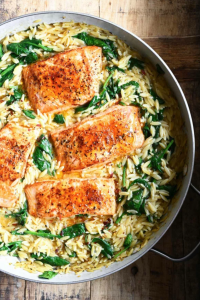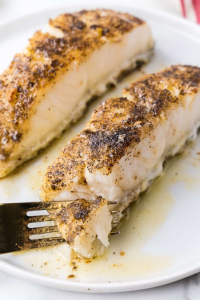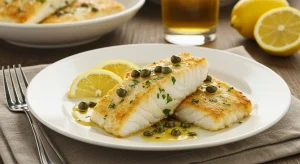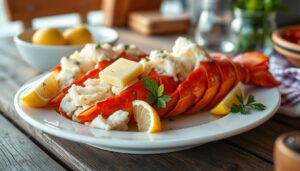When cooking salmon, getting the perfect bake time is key. Baking at 350°F is a favorite method. Knowing how long to bake is essential for a tasty meal. A 2-lb whole salmon filet usually serves 4, making it great for small groups.
To get the best bake time, consider the salmon’s thickness and temperature. The ideal cooking temperature is 425°F. But, baking at 350°F can also yield excellent results. Always check the salmon’s internal temperature, aiming for 145°F for full doneness.
Key Takeaways
- Whole salmon filet typically weighs around 2 lbs
- The recommended serving size is approximately ½ lb of salmon per person
- Baking salmon at 350°F is a popular method for achieving perfectly cooked fish
- Salmon baking time varies depending on the thickness of the fillet
- Understanding how long to bake salmon at 350 is crucial for a delicious meal
- Achieving the perfect salmon bake time requires considering the internal temperature and cooking time
- Cooking temperature for salmon is recommended to be 425°F, but 350°F can also produce great results
Understanding the Basics of Salmon Baking
Cooking salmon in the oven starts with knowing the basics. You need to understand the ideal temperature and cooking time. The best temperature is 350°F. This ensures even cooking and keeps the fish moist.
Choosing the right salmon cut is also crucial. Fillets or steaks have different cooking times. Here are some important points to consider:
- Fillet size: A larger fillet will require a longer baking salmon duration.
- Thickness: Thicker fillets will take longer to cook than thinner ones.
- Salmon type: Wild-caught or farmed salmon may have different cooking requirements.
Having the right equipment is key. You’ll need a baking sheet and an oven. With these basics, you’re ready to cook delicious salmon.
Here’s a quick summary of what to remember when baking salmon:
| Factor | Consideration |
|---|---|
| Bake salmon temperature | 350°F |
| Baking salmon duration | 12-14 minutes per inch of thickness |
| Salmon cut | Fillet or steak, depending on preference |
By following these tips, you’ll get perfectly cooked salmon every time. Always check the salmon’s internal temperature to ensure it’s safe to eat.
Preparing Your Salmon Before Baking
To get the best results, prepare your salmon before baking. Start by patting the fish dry with a paper towel. This step removes excess moisture, ensuring the salmon bakes evenly and browns nicely. Next, season the salmon with salt and pepper, and add herbs or spices to boost the flavor.
A reliable salmon baking guide stresses the importance of not over-preparing the fish. Over-preparation can make the salmon tough or dry. Keep your preparation simple and gentle to preserve the salmon’s delicate flavor and texture. Key steps include:
- PAT the salmon dry with a paper towel to remove excess moisture
- SEASON with salt and pepper to taste
- ADD any desired herbs or spices to enhance the flavor
By following these steps, you ensure your salmon is ready for baking. This will help you achieve the perfect cooking time and a delicious meal. Always check a trusted salmon baking guide for detailed instructions and tips.
| Salmon Fillet Weight | Prep Time | Cook Time | Total Time |
|---|---|---|---|
| 1 lb | 10 minutes | 15 minutes | 25 minutes |
How Long to Bake Salmon at 350 Degrees
To get the perfect salmon bake, knowing what affects cooking time is key. The thickness of the fillet, oven temperature, and desired doneness matter. A good rule is to bake salmon for 12-14 minutes per inch at 350°F.
It’s important not to overcook salmon, as it can become dry and tasteless. The USDA suggests cooking fish to 145°F. But, many chefs believe salmon is best at 140-145°F. Use a food thermometer to check the salmon’s internal temperature.
Timing for Different Fillet Sizes
Smaller fillets bake faster, taking 10-12 minutes. Larger ones might need 15-18 minutes. The type of salmon also affects cooking time, as some are fattier and take longer. Here are some guidelines:
- For a 1-inch thick fillet, bake for 12-14 minutes at 350°F.
- For a 1.5-inch thick fillet, bake for 15-18 minutes at 350°F.
- For a 2-inch thick fillet, bake for 18-20 minutes at 350°F.
Signs of Perfectly Cooked Salmon
A perfectly cooked salmon is flaky and slightly firm. Check by inserting a fork into the thickest part. If it slides in easily and flakes apart, it’s done. To get it right, watch the cooking time closely and adjust as needed. With these tips, you’ll make a delicious, moist salmon dish every time.
Essential Seasoning Techniques
To get the best salmon bake time, focus on key seasoning techniques. Use herbs, spices, and marinades to make a crispy salmon oven roast. A simple mix of garlic powder, kosher salt, and black pepper works well. It’s great for flavor and pairs well with oils like avocado oil.
Here are some seasoning tips:
- Let salmon filets rest at room temperature for 15-30 minutes before cooking for even cooking.
- Cooking with skin on is advised to help prevent the salmon from drying out.
- Use about 2 tablespoons of cooking oil, such as avocado oil or canola oil, for a crispy exterior.
For more flavor, try marinades or other seasoning methods. The secret to a great crispy salmon oven roast is balancing flavors and textures. With the right seasoning, you can make a tasty dish in about 15 minutes.
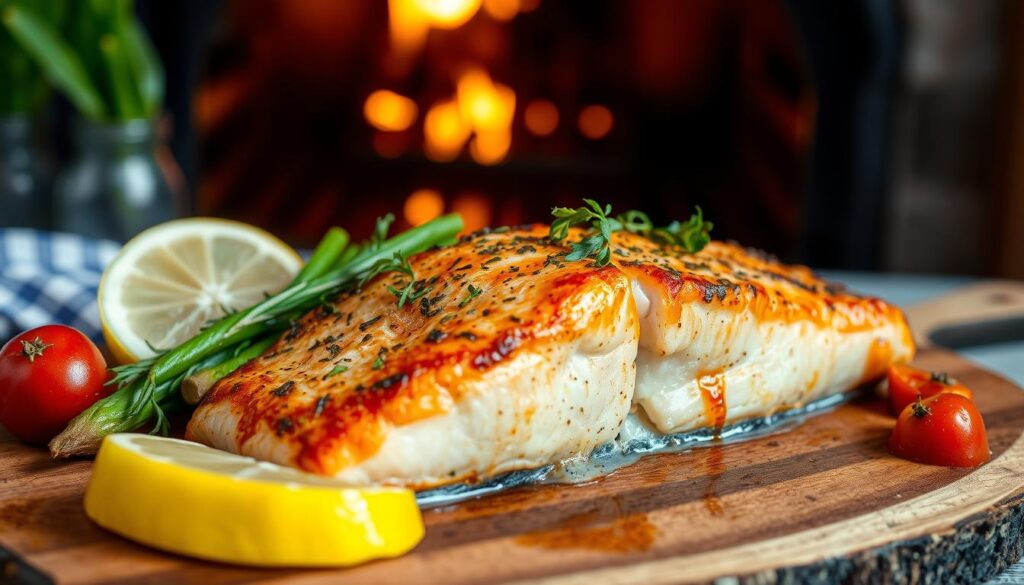
Always cook salmon to at least 145°F (63°C) as per U.S. FDA guidelines. With these seasoning tips, you’ll make a delicious crispy salmon oven roast in no time.
Moisture Control Methods for Perfect Results
When cooking salmon in the oven, controlling moisture is key. Marinades help keep the fish moist and add flavor. The temperature and cooking time also play a big role. For instance, a 3-pound salmon fillet takes about 25 minutes at 350°F.
Using foil or parchment paper can also help manage moisture. Foil keeps moisture in, while parchment paper prevents drying. Finding the right balance is crucial. Remember, the thickness of the salmon affects cooking time. A 1-inch thick fillet bakes in 12-15 minutes at 350°F.
- 4-6 minutes for every ½ inch thickness
- 8-12 minutes for a ½ inch thick salmon fillet
- 10-14 minutes for a ¾ inch thick salmon fillet
- 12-16 minutes for a 1 inch thick salmon fillet
By following these tips and using the right moisture control, you can get perfectly cooked salmon. It will be moist, flavorful, and delicious.
Temperature Testing and Doneness
Cooking salmon right is key for a tasty and safe dish. A good salmon baking guide shows why checking temperature is important. The FDA says salmon is done at 145 degrees F.
To make sure your salmon is just right, use an instant-read thermometer. Cook’s Illustrated recommends 125 degrees F for farmed salmon and 120 degrees F for wild. For a medium finish, aim for 135 degrees F.
Here are some general guidelines for cooking salmon:
- Rare: less than 120 degrees F
- Medium-rare: 125-130 degrees F
- Medium: 135-140 degrees F
- Well-done: over 145 degrees F (not recommended for optimal taste)
The secret to perfect salmon is not to overcook it. Using a food thermometer and a trusted salmon baking guide will help. This way, you’ll get the perfect cooking time and a great meal.
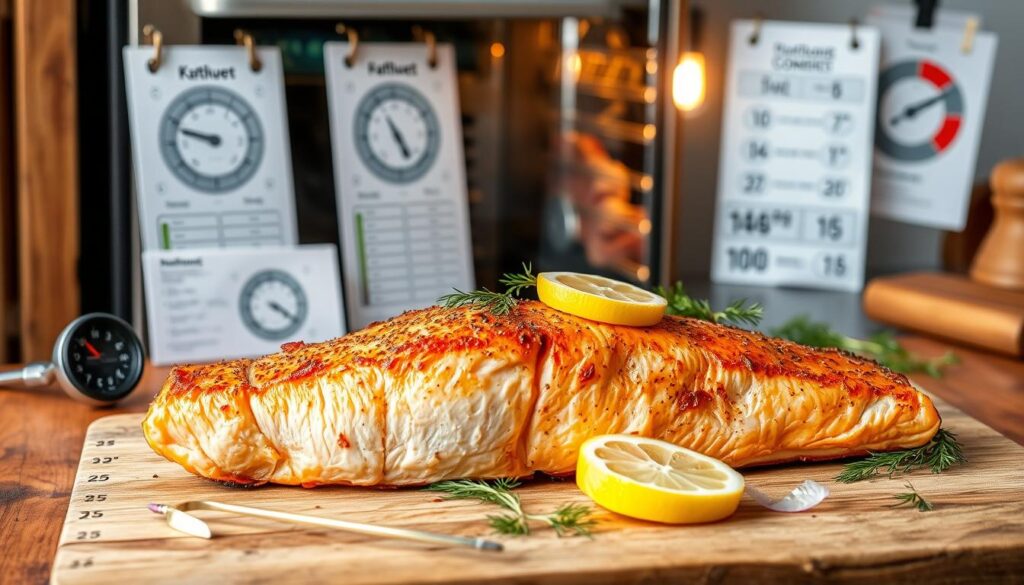
Resting and Serving Your Baked Salmon
After baking salmon at 350 degrees, let it rest for a few minutes. This makes the fish tender and flavorful. The resting time is as important as the baking time. Let your salmon rest for 5 to 10 minutes, covered with foil, to ensure it reaches the ideal internal temperature.
When serving, get creative with your presentation. Here are some plating suggestions:
- Place the salmon on a bed of mixed greens
- Serve with a side of roasted vegetables
- Drizzle with your favorite sauce or dressing
Make your dish look good and taste great. The baking time affects the result, so watch it closely.
Remember, the perfect salmon bake time varies by size and thickness. But with practice, you’ll get a moist and flavorful dish every time.
Here’s a summary of the key points to keep in mind:
| Salmon Size | Baking Time | Internal Temperature |
|---|---|---|
| 6-ounce fillet | 12-14 minutes | 145°F |
| 2-pound side | 15-20 minutes | 145°F |
Follow these guidelines and try different seasonings and presentation styles. You’ll soon make a delicious baked salmon dish that will impress everyone.
Storing and Reheating Leftover Salmon
Storing leftover salmon right is key to keeping it fresh and safe. You can keep it in the fridge for 3-4 days in a sealed container. This stops bacteria from growing and keeps the salmon good for longer.
To reheat your salmon, you can use the oven, air fryer, or stovetop. Make sure it heats up to 145°F (63°C). For a crispy salmon oven roast, heat your oven to 120°C (250°F) and reheat for 10-15 minutes. Or, use an air fryer for 4-5 minutes to get it just right, perfect for the best salmon bake time.
Here are some tips for reheating leftover salmon:
- Use a food thermometer to ensure the internal temperature reaches 145°F (63°C).
- Reheat salmon in smaller portions to prevent degradation of quality and flavor.
- Avoid overcrowding the cooking vessel, as this can result in uneven reheating.
By following these tips and using the right methods, you can enjoy your leftover salmon. Always check for signs of spoilage like a strong fishy smell or ammonia smell before eating.
Conclusion: Mastering Your Salmon Baking Skills
Baking salmon to perfection is an art that can be learned. It takes a bit of practice and paying attention to details. You’ll need to experiment with temperatures, timing, and seasonings to find what you like best.
By using the tips from this guide, you’ll make moist, tasty baked salmon. Your loved ones will love it. Remember, the perfect salmon bake time depends on the salmon fillets thickness. Always use a meat thermometer to check the salmon’s internal temperature, which should be 145°F (63°C).
Try out different seasonings, marinades, and sides to create your own salmon recipe. With a bit of creativity, you’ll soon be a pro at how long to bake salmon at 350 degrees. Enjoy your baking journey!
FAQ
What is the ideal temperature to bake salmon?
The best temperature for baking salmon is 350°F. This ensures it cooks evenly and stays moist and flaky.
How long should I bake salmon at 350°F?
Baking time at 350°F varies with the salmon’s thickness. Generally, bake for 12-15 minutes per inch of thickness.
What are the different types of salmon cuts I can use for baking?
You can bake salmon as fillets, steaks, or whole sides. Choose based on your preference and serving needs.
What equipment do I need for baking salmon?
You’ll need a baking sheet, parchment paper or foil, and a food thermometer. These ensure even cooking and safety.
How should I prepare the salmon before baking?
Pat the salmon dry with paper towels. Season with salt and pepper. Add herbs or spices if you like. But don’t overdo it to avoid dryness.
What are the signs of perfectly cooked salmon?
Perfect salmon is firm, flaky, and reaches 145°F inside. Avoid overcooking to keep it moist.
How can I add flavor to my baked salmon?
Use herbs, spices, and marinades like lemon, dill, garlic, and Dijon mustard. They enhance the flavor.
How can I prevent my baked salmon from drying out?
Use marinades, baste with butter or oil, or wrap in foil or parchment. These methods keep it moist.
How can I tell when my salmon is done?
Use a food thermometer. Salmon is ready at 145°F inside.
How should I store and reheat leftover baked salmon?
Store in an airtight container in the fridge for up to 3 days. Reheat gently in the oven or microwave, avoiding overcooking.

